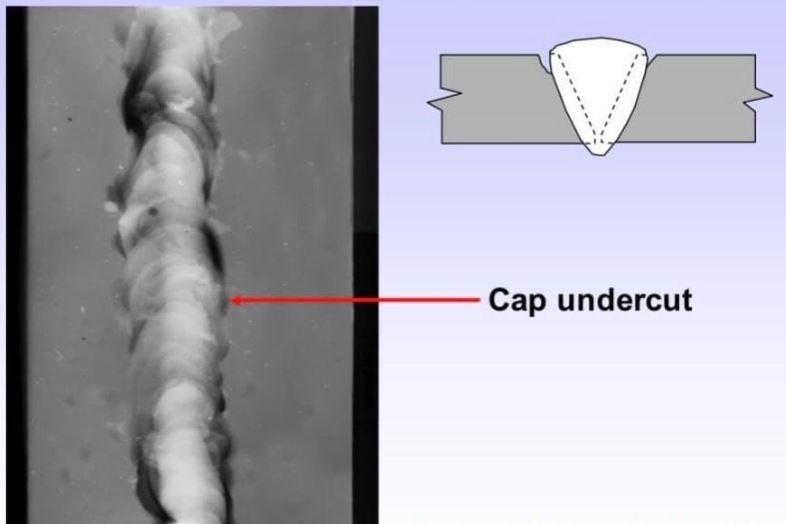Best Practices for Preventing Weld Undercut: Mastering the Basics
Best Practices for Preventing Weld Undercut: Mastering the Basics
Blog Article
Understanding the Causes and Solutions for Undercut Welding in Metal Fabrication Processes
In the realm of metal fabrication processes, the occurrence of undercut welding poses a significant challenge that demands an extensive understanding of its causes and practical services. The elaborate interplay of various factors during welding procedures can bring about this unwanted sensation, affecting the structural stability and overall quality of the bonded joints - Preventing weld undercut. By studying the origin of undercut welding and checking out effective remedial measures, makers can raise the requirement of their workmanship and ensure the manufacturing of perfect metal components
Usual Sources Of Undercut Welding
Often ignored in steel manufacture, undercut welding occurs due to various elements that demand careful focus and proficiency to be efficiently mitigated. Furthermore, incorrect welding methods, such as utilizing the incorrect welding angle or take a trip rate, can also add to damage development. The option of welding specifications, such as voltage, present, and cable feed speed, plays a considerable function in the incident of undercut welding.
Effect of Incorrect Welding Parameters
Unreliable welding specifications can substantially jeopardize the stability and high quality of welded joints in metal fabrication procedures. The influence of wrong welding specifications materializes in different ways, leading to architectural weak points and flaws in the welded components. One crucial aspect influenced by inappropriate welding specifications is the penetration depth of the weld. Not enough warm input because of low welding currents or exceedingly high traveling speeds can result in poor combination between the base steels, causing incomplete joint penetration and damaged bonds. On the other hand, excessive warmth input triggered by high welding currents or slow traveling rates can lead to extreme and burn-through reinforcement, producing a fragile and unpredictable weld framework. Additionally, wrong specifications such as inappropriate voltage setups or incorrect electrode angles can add to erratic weld grain profiles, absence of fusion, and raised chances of issues like undercutting. Consequently, careful attention to welding specifications is paramount to make sure the production of top notch welds with the desired mechanical properties and structural honesty.
Effect of Improper Torch Angle
Improper torch angle in welding operations can substantially affect the high quality and stability of the last weld joints in metal construction processes. The torch angle plays a vital function in figuring out the warm input and circulation throughout welding. When the torch angle is inaccurate, problems such as undercutting can arise. Undercutting is a common welding issue where a groove creates along the weld toe, damaging the joint and endangering its architectural stability.
A lantern angle that is as well steep can bring about not enough penetration, incomplete fusion, and increased spatter. On the various other hand, a lantern angle that is too shallow can cause extreme penetration, burn-through, and distortion of the base product. Preventing weld undercut. Appropriate torch angle is essential for ensuring regular weld high quality, strength, and look
To stop undercutting and various other problems triggered by inappropriate torch angles, welders must be educated to maintain the proper torch angle throughout the welding procedure. Routine monitoring and change of torch angles throughout welding can help attain sound welds with marginal problems.
Role of Inadequate Welding Methods

An additional facet of insufficient welding methods is incorrect weld preparation. Inadequate cleaning of the base metals, wrong joint layout, or not enough side preparation can all contribute to undercut welding. Moreover, inadequate securing gas insurance coverage or making use of the wrong type of gas can result in incomplete blend and the development of undercut problems.
To deal with the role of poor welding methods in metal manufacture procedures, it is important to provide comprehensive training for welders. Correct education on welding parameters, joint prep work, and shielding gas selection can assist avoid undercut welding and ensure high-grade welds browse around this web-site in metal fabrication tasks.
Effective Solutions for Undercut Welding
Resolving undercut welding in metal manufacture needs implementing reliable services to boost weld high quality and architectural stability. Among the primary remedies to fight undercut is to readjust welding specifications such as voltage, existing, and travel rate to ensure appropriate heat input and combination. By fine-tuning these settings, welders can prevent extreme melting of the base steel and filler material, minimizing the probability of undercut development.
Furthermore, correct joint preparation is essential in protecting against undercut. Making certain tidy base metal surface areas cost-free of contaminants and utilizing the proper bevel angle can help advertise much better weld infiltration and minimize the threat of undercut - Preventing weld undercut. Using ideal welding techniques, such as oscillating the lantern or weaving, can also aid in dispersing heat equally and filling the weld joint effectively, minimizing the possibility great site of undercut problems
In addition, picking the correct welding consumables, including electrodes and filler metals, is vital in minimizing undercut. Making use of materials with appropriate chemical structures and mechanical buildings can add to achieving audio welds with minimal undercut. Regular inspection and quality control steps ought to likewise be executed to discover and attend to undercut problems immediately, making sure the general stability of produced metal components.

Conclusion
To conclude, recognizing the reasons and remedies for undercut welding in steel construction processes is crucial for achieving high-quality welds. By resolving usual reasons such as inaccurate welding parameters, inappropriate lantern angle, and insufficient welding techniques, welders can prevent damaging and make sure strong, durable welds. It is important to take notice of these elements and execute reliable options to improve the total welding procedure and final item high quality.

Report this page